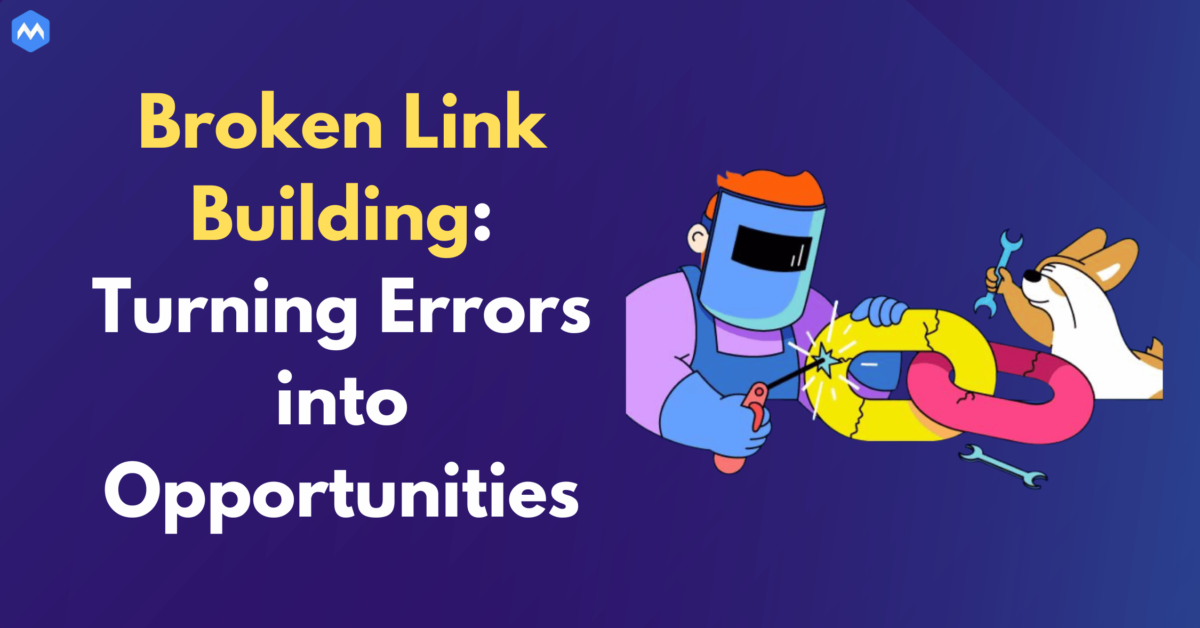Broken Link Building: Turning Errors into Opportunities
Broken link building is one of the most widely used link-building tactics around. It’s the fifth most widely used tactic, according to Aira’s annual State of the Link-building report, which crowdsources opinions from over 250 digital marketing professionals. For the typical site owner, navigating the complex world of search engine optimisation can be difficult.
The concept of identifying dead hyperlinks to enhance your web page visibility might sound daunting.
Yet, with the right tools and a keen grasp of broken link building, any webmaster can advantage of this potent SEO strategy for valuable backlink opportunities.
This guide will show you everything you need to know about broken link building.
Broken Link Building Meaning
Broken link building refers to creating new backlinks to your website from existing links no longer pointing to their original intended destination.
The advantage of broken link building is that you have the opportunity to claim links that may once have gone to a competitor. To complement the work you’ll be doing creating content, developing tools, and developing other engaging things to draw traffic and links, broken link building is frequently a great way to establish authority up front. Checking in monthly, quarterly, or annually, depending on the frequency of conversation about topics relevant to you, will consistently yield new broken link building opportunities.
Broken Link Building Tool
1. Check my links.
Check My Links is a popular free plugin for identifying broken links on individual web pages. It is designed for developers, content editors, and online publishers to fix faulty hyperlinks in their content. It can also be used to peruse public content on most websites. Researchers can use Check My Links to verify connectivity in their content, ensuring topical relevance and increasing editorial interest. It is faster than blindly identifying broken links.
2. ExpiredDomains.net
ExpiredDomains.net is a database of expired domains and deleted or dropped domains, sorted by backlink data. It helps in identifying dead backlinks and sifting through entire domains. The site also partners with site surveyor services to view URLs linking live domains to dead websites. This top-down approach makes the process of finding dead links faster than the bottom-up approach of sifting through individual pages. Expired domains are available on Archive.org and Archive.org.
3. Xenu’s Link Sleuth
Link Sleuth is a software program designed to find broken links on hundreds of pages. It works like an Internet detective, following every link on a domain and testing for connective errors. Although incompatible with OS X software, it’s ideal for self-taught teachers learning web construction. The program outputs an HTML report customized with filters like redirected URLs and sitemaps. The average time spent sifting through links on a medium-to-small-sized website is less than 5 minutes. It’s also ideal for writers and publishers checking links on multiple sites.
4. Linkody
Linkody is a user-friendly service that tracks changes in backlink status for a small monthly fee. Users can monitor their links on all related domains and competitors’ backlinks. The service also offers support for multiple users, instant link location, and link analytics. Its “Disavow” feature allows users to focus on cultivating the best links, saving time and effort. Linkody is an excellent tool for building a list of fixable links.
5. Ahrefs
For backlink builders who take their game seriously and want to identify broken links as quickly as possible with the least amount of hair-pulling or relevance-questioning, Ahrefs is a necessary toolkit. Even though it might be expensive, over time, the time saved by using it will be significantly greater than the time required to become familiar with and use practically any single tool available.
Broken Link Building Strategy:
1. Identifying Broken Links:
The first step in broken link building is identifying broken links on external websites. This can be done using various tools like broken link checkers or browser extensions. Additionally, Google Search Console can provide insights into broken links that point to your site. By regularly monitoring and analyzing your website’s backlink profile, you can also discover broken links that are pointing to your site from other domains. This allows you to reach out to the webmasters of those domains and suggests replacing the broken links with relevant ones, benefiting both parties involved.
2. Creating Quality Content:
Before reaching out to webmasters to report broken links, it’s essential to create high-quality, relevant content on your site. Having valuable content increases the likelihood that webmasters will be interested in replacing broken links with links to your content.
3. Outreach and Communication:
Craft a personalized and polite outreach message to notify webmasters about the broken links on their site. Provide the exact location of the broken link and suggest your content as a replacement. Building relationships through effective communication is key to the success of broken link building. By establishing a genuine connection with webmasters, you can foster long-term relationships that may lead to future collaboration opportunities. Additionally, regularly monitoring and updating your own site’s content ensures that you always have fresh and relevant resources to offer as replacements for broken links.
4. Offer Solutions:
Instead of merely pointing out the broken link, offer a solution. If you have relevant content on your site, provide the webmaster with the exact link they can use to replace the broken one. This makes the process smoother and increases the chances of a positive response.
5. Show Appreciation:
When reaching out to webmasters about broken links, express your gratitude for their website and the value it provides to users. By acknowledging their efforts, you establish a positive tone and increase the likelihood of a favourable response. Remember, building relationships is key in this process. By showing appreciation for their website, you also demonstrate that you have taken the time to familiarize yourself with their content and understand its importance. This personal touch can help foster a sense of collaboration and make webmasters more willing to assist you in fixing broken links.
6. Follow up:
After offering a solution or suggesting a replacement link, don’t forget to follow up with the webmaster. Politely inquire if they were able to make the necessary changes or if they need any further assistance. This shows your commitment to helping them improve their website and reinforces the potential for future collaboration opportunities. By maintaining open communication with the webmaster, you can also establish a professional relationship and build trust. Additionally, offering your expertise and assistance beyond just providing a solution can leave a lasting impression and make them more likely to seek your advice in the future.
Conclusion
For anyone who is looking to grow their business or website using search engine optimization, building broken links is an effective tool to have. Building authority online takes time and effort, but it pays dividends.
At Metaloop Marketing Group, we have all the tools you’ll need to truly build something special. Get in touch with the team today to learn more. Whether you are a small startup or an established company, our team at Metaloop Marketing Group understands the importance of building a strong online presence. With our expertise in search engine optimization and link-building strategies, we can help your business climb the ranks and attract more organic traffic. Don’t miss out on the opportunity to take your website to new heights – contact us now and let us show you how we can make a difference for your business.



Write a Comment